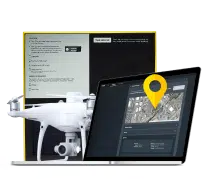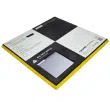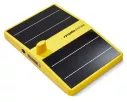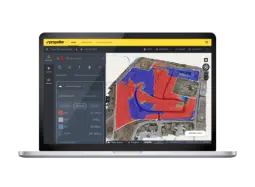Propeller’s Drone Guide: DJI Solutions for Commercial Operations
At Propeller we love testing new drone hardware and we are processing hundreds of drone data sets every day. Our team, which includes several experienced drone pilots, is confident about what makes a good surveying drone.
But if you’ve looking at drone solutions for surveying, it might surprise you what that drone looks like.

Propeller has partnered with DJI, and we’ve done this because we really believe the team at DJI are making the best drones available today, regardless of price.
Propeller’s team has done lots of flight time on custom-built open source drones and love working hands-on with the technology, but with reliability, powerful features, great prices and availability, DJI’s multi-rotors have become a clear choice for most consumer and business applications.
They combine consumer-grade usability and design with commercial-grade reliability and features such as purpose-built camera sensors, extended flight time, advanced collision avoidance and compatibility with a wide range of accessories. Plus, they are available from hundreds of distributors globally — great for access to spares and accessories whenever you need them.
So, if you want to start using drones on your site, here is the list of aircraft you should consider:
Matrice 600

The Matrice 600 (M600) is the largest drone offered by DJI, which has approximately 1.15m wingspan and weighs 9.1kg. This drone is so big that often is not ideal as an aerial surveying unit unless you are operating in harsh weather conditions or under the special safety requirements.
Aside from this it has a flight time of 15–40 minutes depending on the payload, which can reach up to 6kg. With small DJI Zenmuse cameras Matrice 600 can achieve 30-plus minutes of flight time while being able to fly in a wide range of temperatures (-10/+40) and high-wind conditions.
Some advantages of M600
- Triple modular redundancy system is available for IMU, compass and GPS
- Six-rotor and six-battery configuration; this offers advanced redundancy and may be required to fly in some locations
- When combined with the relevant equipment can hold all the cameras and sensors offered by DJI
Weak points
- High price which starts from 4,599 USD (excluding gimbal and camera)
- In most countries, you can only fly M600 if you are a certified drone pilot
Compatible cameras
DJI Zenmuse X3 (comes with the Matrice 100 and provides great base level performance suitable for most use-cases)
- 12 megapixels
- 1/2.3″ sensor
DJI Zenmuse X5 (bigger than the Zenmuse X3 and will reduce flight time).
- 16 megapixels
- Micro 4/3 sensor
DJI Zenmuse X5R (same 16Mp camera as the X5, but offering RAW video footage; great for high-end video production, but rarely called for in surveying or inspections).
DJI Zenmuse XT (IR/thermal) (available in radiometric and nonradiometric varieties depending on whether you need to measure point temperature or not).
DJI Zenmuse Z3
- 12 megapixels
- 1/2.3″ sensor
- 22mm–77mm effective focal length, for 3.5x optical zoom
DJI Zenmuse Z30
- 12Mp sensor
- 1/2.8” sensor
- 10mm to 1200mm effective focal length, for a pretty amazing 30x optical zoom
Plus a range of cameras from Micro Four Thirds systems to the RED Epic through Ronin-MX gimbal.
Matrice 100
The Matrice 100 (M100) flight platform is the drone of choice when it comes to mapping, surveying, and inspections. It combines DJI easy-to-fly technology with professional degree of stability, durability flight time and compatibility with various sensors. Another important feature is the ability for all Zenmuse cameras to be fully articulated — i.e., they can look “up.” This is crucial for getting oblique shots underneath an inspection point to improve 3D model construction, detail and accuracy. It’s a key difference with the Phantom 4.
Some advantages of M100
- Dual batteries support for extended flight time of about 30–40 minutes
- Guidance support for tight space flying or inspecting a large towers and buildings
- Durable design which is good for industrial applications
- Optimized for easy programming and automated flights
Weak points
- Requires pilot certification in some countries
Compatible cameras
All Zenmuse cameras and gimbals (see detailed list in the M600 section)
Inspire 1
Inspire 1 is a very popular model targeted towards drone cinematography. It can be used for surveying and inspection but it suffers from short flight time (18–15 mins). We would only recommend this drone for surveying if you already have one and you want to use it together with Propeller AeroPoints or other GCP solution.
Some advantages of Inspire 1
- Two controllers, one for the drone and another one for camera control
- Advanced stabilization helps to hold aircraft position at all times
Weak points
- The battery is too weak and additional batteries are expensive
- Requires pilot certification in some countries
Compatible cameras
Inspire 1 supports all the cameras outlined in Matrice 100 section but WILL NOT support the Zenmuse Z30 and nor will it support the Zenmuse X4S AND Zenmuse X5S which are available on the Inspire 2.
Inspire 2
The newest drone from DJI also designed for aerial cinematographers. Among the main improvements, as compared to the previous model, is dual-battery support and the self-heating technology which allows you to operate this drone even in -20C.
Some advantages of Inspire 2
- Improved flight time up to 27 minutes
- 5.2K video capture and processing
- PCIe SSD storage
- Advanced obstacle avoidance system
Weak points
- The drone, compatible cameras and accessories are pricey
- Noncompatible with older generations cameras and accessories from Inspire 1
- Requires pilot certification in some countries
Compatible cameras
Zenmuse X4S and X5S are both 20Mp cameras with modern sensors that deliver the best level of clarity.
DJI Zenmuse X4S
- 20Mp resolution
- 1” sensor size (similar to the Phantom 4 camera)
- Mechanical shutter
- Aperture control
- Fully articulated gimbal (important for inspections to capture oblique images)
DJI Zenmuse X5S
- 20Mp resolution
- Micro 4/3rds Sensor size
ISO, shutter, aperture and focus control (these features are not required for surveying operations but they can help to achieve better image clarity in various lighting and weather conditions and can improve your 3D models. Most of the cameras mentioned in this post can adjust these settings automatically, but Inspire 2 allows you to do a manual setup).</
Phantom 4

Falling into prosumer category, Phantom 4 is the DJI’s bestselling aircraft and a good drone for surveying and inspections. With a set of spare batteries, Phantom 4 can be used to survey small to medium-sized sites or inspect roofs and telecom towers. The good things about Phantom 4 is that it is available from hundreds of resellers, comes with a convenient semi-hard case, features a built-in camera and offers forward collision avoidance.
Some advantages of Phantom 4
- Setup and control is extremely easy. Literally anyone could fly a Phantom 4
- Portability and weight which falls into “sub-2kg” category
- Autonomous flight features and smart flight modes
Weak points
- Collision avoidance is not perfect and only works for front objects
- Non-interchangeable camera and lens
- Tablet or mobile needed to control the drone
Camera specifications
- 1/2.3” sensor size
- 12Mp resolution
Phantom 4 Pro
Phantom 4 Pro is the latest iteration from DJI literally bridging the gap between consumer and commercial drone technology. This drone is perfect for surveying and inspections given the full 360° collision avoidance system, increased camera pixel counts and sensor size. The Phantom 4 Pro has an incredible 28–30 minutes flight time which is a dramatic increase over any drone of this size and price.
Some advantages of Phantom 4 Pro
- Remote control with integrated tablet
- Five sensor for advanced obstacle avoidance
- The most advanced set of features for this class
Weak points
- Non-interchangeable camera and lens
Camera specification
- 1-inch sensor size
- 20Mp resolution (better camera resolution decreases the need to fly lower in order to achieve the desired Ground Sampling detail)
- Mechanical shutter (important for clearer shots which improves the software’s ability to capture vertices to create better point clouds and more accurate 3D models).
- Aperture control (not drastically important but can help to reduce light reflection in sunny conditions and improve 3D models quality)
Summary
At this point our number-one choice for commercial operations is the Matrice 100 that can produce great results and carry a variety of cameras which you can incorporate across your businesses whether surveying or inspecting.
If you are after a smaller, sub-2kg drone, the Phantom 4 Pro is the next best device that features an increased sensor size and will improve your 3D modeling performance. Being a newer DJI model, it has more collision avoidance sensors and an improved flight stability. However note that in high wind conditions the Matrice 100 will still outperform Phantom 4 Pro.
If you want to find more info on drones for your specific use case or you are considering the purchase of a bundled drone solution, please contact us.
You might also like:
Turn Your Phantom 4 RTK Drone into PPK with Propeller’s Easy Upgrade
How Does Better Data Capture Make the Role of the Surveyor on Site More Important Than Ever?
How Accurate is the new DJI Phantom 4 RTK?









